In 1995, household refrigerators and freezers were the first product group for which 'Brussels' prescribed a mandatory energy label. The measure for energy efficiency, an index with base value of 100, was derived from the average efficiency of fridges and freezers in 1992.
Since 2016, is this index lower than 40, implying an energy efficiency improvement of 60% over what was believed to be a technically 'mature' and efficient product in 1992.
Source: estimations from the Ecodesign Impact Accounting Overview Report 2024
Scope
The following table shows some examples of products in scope and out of scope of the Ecodesign Regulation:
| In Scope | Out of Scope |
|---|---|
|
|
Check the complete list in the Ecodesign Regulation and Energy Labelling Regulation.
Ecodesign Requirements
Rules on ecodesign for refrigerating appliances are mandatory for all manufacturers and importers wishing to sell their products in the EU.
From 1 March 2021, the Regulation on ecodesign requirements of refrigerating appliances (EU) 2019/2019 repeals and replaces Regulation (EC) 643/2009.
For the first time, the ecodesign measures will include requirements for reparability and recyclability, which will contribute to circular economy objectives by improving the life span, maintenance, re-use, upgrade, recyclability and waste handling of appliances.
Energy Label
The EU energy labels for household fridges and freezers use, as of 1 March 2021, a scale from A (most efficient) to G (least efficient). The labels provide information on the product’s
- energy efficiency class
- energy consumption
- storage volume(s)
- whether or not it has a freezer compartment
- noise emissions
The label for wine storage appliances also shows the number of bottles that can be stored.
The European Product Registry for Energy Labelling (EPREL) offers more detailed information on models placed on the EU market. This can be accessed by scanning the QR code featured on the new energy labels.
| Understanding the Refrigeration Energy Label | |
|---|---|
 |
|
Highlights
Compared to 1992 when Ecodesign and Energy Labelling measures first appeared for fridges, in 2020 a typical household fridge consumed much less electricity (62%) while doubling the volume.
Facts & Figures
This graphic shows the estimated sales, stock, energy consumption (primary, electric or fuel), greenhouse gas emissions, consumer expenses and business revenues for years 2010 and 230. The estimated values inside the graph bars are those from the EIA ECO-scenario, they include the effects of Ecodesign and Energy Labelling measures.
The difference with the business as usual (BAU) scenario without these estimated measures is shown next to the graph bar. These figures indicate the estimated savings obtained due to the measures.
Product: (Household) Refrigeration Appliances Measures: Regulation (EU) 2019/2019, Regulation (EU) 2019/2016 |
|---|
| The striped lines in the charts show the 'Effect of the Regulations' |
SALES (x million units) 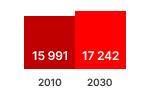 | STOCK (x million units) 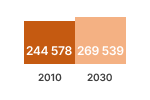 | ELECTRICITY (TWh/a) 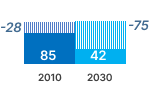 |
GHG-EMISSION 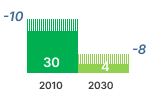 | CONSUMER EXPENSES 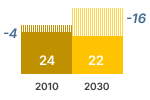 | REVENUES 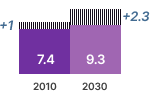 |
Source: estimations from the Ecodesign Impact Accounting Overview Report 2024
In 2020, 258 million household refrigerators and freezers were in use in the EU27. They cooled a net volume of 76.6 million m3, of which 22% frozen at -18°C and 78% refrigerated at +5°C.
92% of the fridges is used in the residential sector, implying 391 litres cooled volume per household. The number of fridges and the net volume per fridge are both increasing with time.
In 1990, the average electricity consumption of sold refrigerator-freezers was 477 kWh/a. Without measures, in 2020 this would have been 417 kWh/a, but due to Ecodesign and Energy Labelling it was reduced to 181 kWh/a (-56%). In 2030 a further decrease to 114 kWh/a is expected.
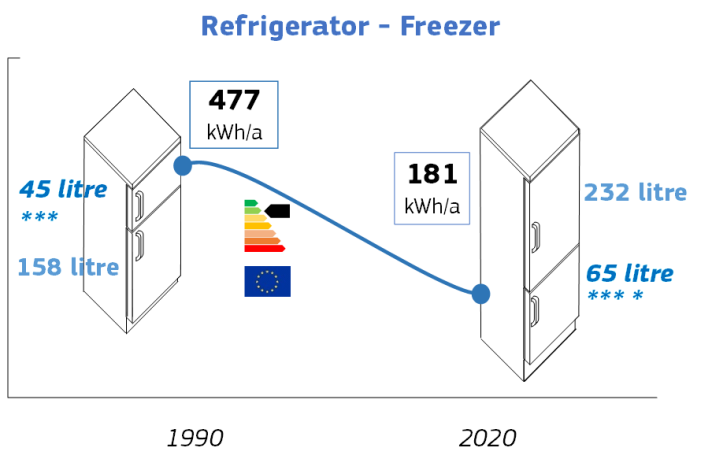
The regulations saved 55 TWh of electricity in 2020, projected to increase to 75 TWh by 2030. This means a 64% saving due to Ecodesign and Energy Labelling measures.
The 2030 savings are 3.1% of the total EU27 electricity consumption in 2020, and close to the annual electricity consumption of Finland or Belgium.
Due to Ecodesign and Energy Labelling measures, EU27 users saved € 8.8 billion on household refrigeration in 2020, projected to increase to € 16.1 billion in 2030. This is a 43% saving due to the measures taken.
In 2030, the annual household refrigeration expenses decrease from € 175 (without measures) to € 101.
Expected Savings
EFFICIENCY
he energy efficiency of refrigerating appliances is expressed as the Energy Efficiency Index (EEI). A lower EEI indicates higher energy efficiency. Ecodesign regulations and Energy Labelling schemes have stimulated lower EEI values for refrigerating appliances.
The EIA ECO scenario represents the combined impacts of all measures taken since the introduction in 1992 of the first labelling requirements (Directive 92/75/EC). In this scenario, the average EEI of refrigerating appliances was 32 in 2020, which corresponds to an annual electricity consumption (AEC) of 181 kWh/a/unit. Without measures, the EEI value would have been 74, corresponding to 410 kWh/a/unit.
Energy Efficiency Index (EEI) and Annual Electricity Consumption (AEC) for Scenarios with and without Measures
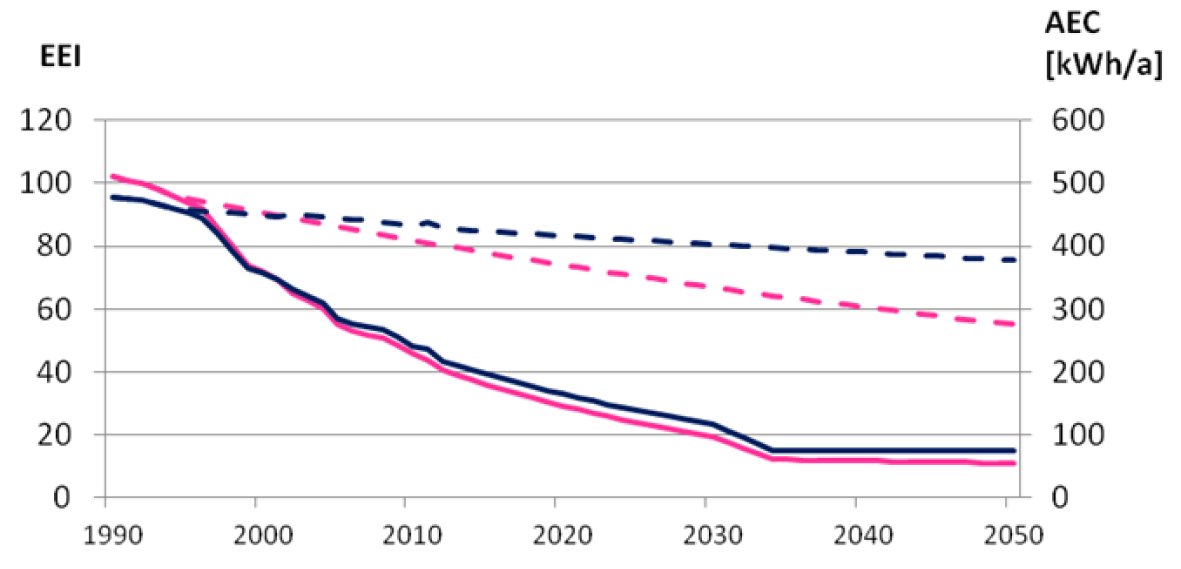

As a consequence, the 2020 total EU27 electricity use was 61 TWh/a instead of the 116 TWh/a that would have been reached without measures (-55 TWh/a).
The projected EEI value for 2030 is 19, equalling an A+++ label (old scale), and corresponding to 114 kWh/a, 37% less than in 2020. Total electricity consumption in EU27 in 2030 is expected to be 42 TWh/a. This is 19 TWh/a less than in 2020 and 75 TWh/a less than the 2030 consumption in a scenario without measures
Source: estimations from the Ecodesign Impact Accounting Overview Report 2024

Suppliers
Suppliers shall ensure that:
a) each refrigerating appliance is supplied with a printed label in the format as set out in Annex III;
(b) the parameters of the product information sheet, set out in Annex V, are entered into the product database;
(c) if specifically requested by the dealer, the product information sheet shall be made available in printed form;
(d) the content of the technical documentation, set out in Annex VI, is entered into the product database;
(e) any visual advertisement for a specific model of refrigerating appliances contains the energy efficiency class and the range of energy efficiency classes available on the label in accordance with Annex VII and Annex VIII;
(f) any technical promotional material concerning a specific model of refrigerating appliances, including technical pro motional material on the internet, which describes its specific technical parameters includes the energy efficiency class of that model and the range of energy efficiency classes available on the label, in accordance with Annex VII;
(g) an electronic label in the format and containing the information, as set out in Annex III, is made available to dealers for each refrigerating appliance model;
(h) an electronic product information sheet, as set out in Annex V, is made available to dealers for each refrigerating appliance model.

Dealers
Dealers shall ensure that:
(a) each refrigerating appliance, at the point of sale, including at trade fairs, bears the label provided by suppliers in accordance with point 1(a) of Article 3, with the label being displayed for built-in appliances in such a way as to be clearly visible, and for all other refrigerating appliances in such a way as to be clearly visible on the outside of the front or top of the refrigerating appliance;
(b) in the event of distance selling, the label and product information sheet are provided in accordance with Annexes VII and VIII;
(c) any visual advertisement for a specific model of refrigerating appliance, including on the internet, contains the energy efficiency class and the range of energy efficiency classes available on the label, in accordance with Annex VII;
(d) any technical promotional material concerning a specific model of refrigerating appliance, including technical promotional material on the internet, which describes its specific technical parameters includes the energy efficiency class of that model and the range of energy efficiency classes available on the label, in accordance with Annex VII.

Policy
Ongoing legislative work
Please check the ongoing initiatives on the Have your say portal.
Regulation (EU) 2019/2019 of 1 October 2019 laying down Ecodesign requirements for refrigerating appliances pursuant to Directive 2009/125/EC of the European Parliament and of the Council and repealing Commission Regulation (EC) 643/2009 (OJ L 315, 5.12.2019, pp. 187-208).
Regulation (EU) 2019/2016 of 11 March 2019 supplementing Regulation (EU) 2017/1369 of the European Parliament and of the Council with regard to Energy Labelling of refrigerating appliances and repealing Commission Delegated Regulation (EU) 1060/2010 (OJ L 315, 5.12.2019, pp. 102-133).
What is the aim of the regulations?
Commission Regulation (EU) 2019/2019 establishes Ecodesign requirements for the sale or putting into service of electric mains-operated* refrigerating appliances with a capacity of between 10 and 1,500 litres.
Delegated Regulation (EU) 2019/2016 lays down rules on the labelling of, and supply of additional product information on, these refrigerating appliances.
Key points
Commission Regulation (EU) 2019/2019:
- sets out in Annex II the dates when the Ecodesign requirements come into force — 1 March 2021 in the first instance and more stringent measures from 1 March 2024. These cover
- energy efficiency
- functional aspects
- resource efficiency
- information for installers and end-users;
- sets out the conformity assessment procedure, and in Annex III the measurement methods and calculations, that must be followed.
National authorities must apply the verification procedures laid down in Annex IV when carrying out market surveillance checks.
Manufacturers, importers or their authorised representatives must not offer for sale products capable of detecting when being tested and changing their performance accordingly.
Annex V sets out indicative benchmarks based on the best-performing products and technologies available for refrigerating appliances in terms of their energy efficiency index and noise emissions.
The regulation repeals Regulation (EC) 643/2009 from 1 March 2021.
From when do the regulations apply ?
They both apply from 1 March 2021.
Background
Directive 2009/125/EC establishes a framework to set Ecodesign requirements for energy-related products. It tasks the Commission to set these for products which are widely sold and traded in the EU and have a significant environmental impact. Regulation (EU) 2017/1369 establishes a framework to set Energy Labelling requirements for energy-related products to enable consumers to choose more efficient products to reduce their energy consumption.
For more information, see:
- Review of Ecodesign requirements for household cold appliances (European Commission).
Disclaimer: please pay attention to possible updates/changes as indicated in the Official Journal (green dot)
Useful Links
- Regulation (EU) 2017/1369 of the European Parliament and of the Council of 4 July 2017 setting a framework for Energy Labelling and repealing Directive 2010/30/EU (OJ L 198, 28.7.2017, pp. 1-23)
- Directive 2009/125/EC of the European Parliament and of the Council of 21 October 2009 establishing a framework for the setting of Ecodesign requirements for energy-related products (OJ L 285, 31.10.2009, pp. 10-35)
Regulation (EU) 2021/340 amending Regulations (EU) 2019/2013 to 2018
Regulation (EU) 2021/341 amending Regulations (EU) 2019/424, 1781 and 2020 to 2024
Commission Communication: Harmonised standards for household refrigerating appliances 2014/C 22/03

